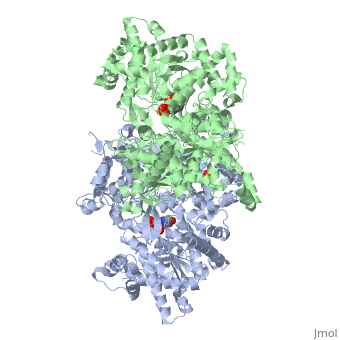Glycogenolysis: Difference between revisions
Jump to navigation
Jump to search
No edit summary |
No edit summary |
||
| Line 1: | Line 1: | ||
<StructureSection load='1ygp' size='350' side='right' caption='Yeast glycogen phosphorylase dimer with pyridoxal-5-phosphate and phosphate (PDB entry [[1ygp]])' scene=''> | <StructureSection load='1ygp' size='350' side='right' caption='Yeast glycogen phosphorylase dimer with pyridoxal-5-phosphate and phosphate (PDB entry [[1ygp]])' scene=''> | ||
Glycogenolysis is the breakdown of glycogen (n) to glucose-1-phosphate and glycogen (n-1). Glycogen branches are catabolized by the sequential removal of glucose monomers via phosphorolysis, by the enzyme glycogen phosphorylase. | Glycogenolysis is the breakdown of glycogen (n) to <scene name='94/942621/Cv/3'>glucose-1-phosphate</scene> and glycogen (n-1). Glycogen branches are catabolized by the sequential removal of glucose monomers via phosphorolysis, by the enzyme [[glycogen phosphorylase]]. | ||
</StructureSection> | </StructureSection> | ||
== References == | == References == | ||
<references/> | <references/> | ||
Revision as of 18:40, 18 December 2022
Glycogenolysis is the breakdown of glycogen (n) to and glycogen (n-1). Glycogen branches are catabolized by the sequential removal of glucose monomers via phosphorolysis, by the enzyme glycogen phosphorylase. |
| ||||||||||
